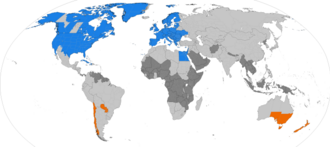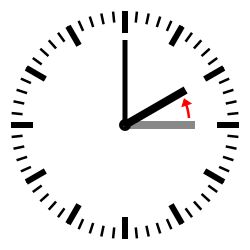Daylight Saving Time

Daylight Saving Time (DST) or Summer Time (ST) is a time to time keep during summer. During the summer months, the sun stays visible for a longer time, and sunset happens late in the day. For this reason, certain countries advance the time by one hour near the start of summer, and put it back one hour during autumn.
DST helps stores that sell to people after they get off work, and it doesn't hurt farmers and others whose hours are set by the sun. It cuts traffic accident rates. Sometimes it can reduce energy costs, but it can also increase them.
Most of the world's countries do not use DST, but it is common in Europe and North America.
The United States, Australia, the United Kingdom, Canada and many other countries have DST. These countries also have regions that do not have DST:
- United States: most of Arizona and Hawaii
- Australia: Queensland, Western Australia and the Northern Territory
- Canada: Saskatchewan except for a few locations with the border with Alberta and Manitoba, and the Yukon Territory
Iceland, Russia, Belarus, and some parts of Ukraine are countries in Europe without DST.
US dates and UK Time
Since 1971 all clocks in the European Union, of which the UK is a member state, have changed on same dates and at the same time, 06:00 GMT.[1][2]
Against are many farmers in northerly latitudes, because sunrise would occur in winter at about 10:00 in the morning. However, in March 2010 the National Farmers Union said that it was not against Single/Double Summer Time, and is in fact relatively neutral, with many farmers expressing a preference for the change"Should we change the clocks?". National Farmers Union. Mar 18, 2010. Archived from the original on Mar 30, 2010. Retrieved Sep 23, 2015.
Automatic adjustment
Some computers connected to the Internet will automatically adjust their clocks for DST. Most newer computers will not adjust or will adjust the time incorrectly or on the wrong date. Also, computers with more than one operating system may be incorrectly adjusted twice or more when each operating system boots.
References
- ↑ British Summer Time Archived September 2, 2016, at the Wayback Machine
- British Summer Time starts: Mar 28, 2021
- British Summer Time ends: Oct 31, 2021
- British Summer Time clocks change at 06:00 (07:00) Greenwich Mean Time (GMT).
- US 2013 date: March 10
- US 2012 date: March 11
- US 2011 date: March 13
- US 2010 date: March 14
- US 2009 date: March 8
- US 2008 date: March 9
Permanent GMT+1
Permanent Summer Time has support in some northerly countries such as the UK. It was tried in the British Standard Time experiment, with Britain remaining on GMT+1 throughout the year. This took place between 27 October 1968 and 31 October 1971.
There are proposals for GMT+1 in the winter, and DST summer time (GMT+2) in the summer. In favour are most city dwellers: children do not have to come home after school in the dark, and late afternoon and early evening activities benefit. In favour also were those concerned with accidents, because both accidents and fuel consumption go down.RoSPA suggests this would reduce the number of accidents over this period as a result of the lighter evenings. "Press Release October 22, 2008 It's Time for a Change to Save Lives and Reduce Injuries". RoSPA Press Office. Archived from the original on Mar 17, 2009. Retrieved Sep 22, 2016."British Summer Time (BST)". NMM – National Maritime Museum. Archived from the original on 2009-08-02. Retrieved 2016-09-22.
- ↑ Jha, Alok (Mar 29, 2010). "Lighter Later Guardian Article". The Guardian (London). http://www.guardian.co.uk/environment/2010/mar/29/lighter-later-climate-change-campaign.
Other websites
- Daylight Saving Time – Time Change. TimeAndDate.com
- About Daylight Saving Time - History, rationale, laws & dates. WebExhibits

